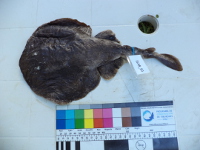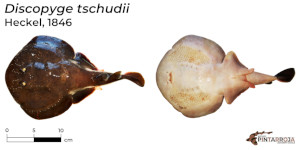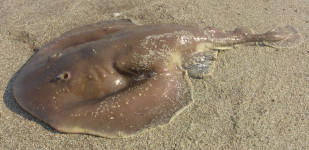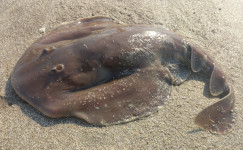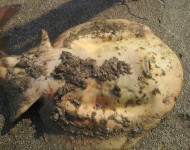Discopyge tschudii
Heckel, 1846
Apron ray
Classification: Elasmobranchii Torpediniformes Narcinidae
Reference of the original description
Discopyge tschudii. In von Tschudi, J.J., Untersuchungen über die Fauna Peruana. Part Ichthyologie, Scheitlin & Zollikofer, St. Gallen. 1844–46. pp.32-35
Discopyge tschudii. In von Tschudi, J.J., Untersuchungen über die Fauna Peruana. Part Ichthyologie, Scheitlin & Zollikofer, St. Gallen. 1844–46. pp.32-35
Synonyms / new combinations and misspellings
Discopyge tschuddi, Discopyge tschudi, Torpedo chilensis
Discopyge tschuddi, Discopyge tschudi, Torpedo chilensis
Description :
Citation: Discopyge tschudii Heckel, 1846: In: Database of modern sharks, rays and chimaeras, www.shark-references.com, World Wide Web electronic publication, Version 01/2026
Please send your images of "Discopyge tschudii" to info@shark-references.com
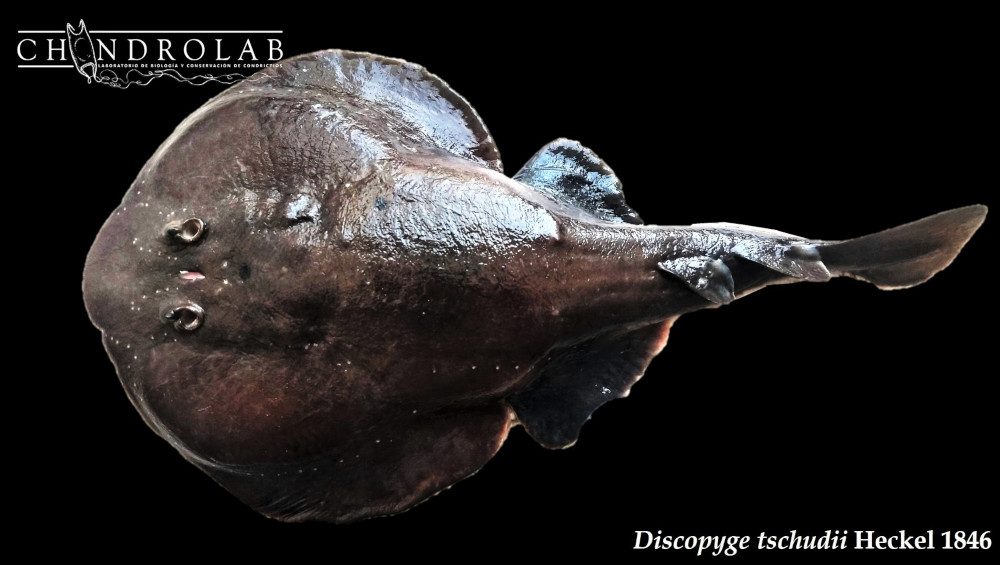
Discopyge tschudii Heckel, 1846, Chile © Francisco Concha, Condrolab, Universidad de Valparaíso, Chile

Discopyge tschudii Heckel, 1846, Chile © Francisco Concha, Condrolab, Universidad de Valparaíso, Chile
Common names
 Raja elcectric,
Raja elcectric,  Raya eléctrica,
Raya eléctrica,  Tembladera,
Tembladera,  Tremolina,
Tremolina,  Apron ray,
Apron ray,  Electric ray
Electric ray
 Raja elcectric,
Raja elcectric,  Raya eléctrica,
Raya eléctrica,  Tembladera,
Tembladera,  Tremolina,
Tremolina,  Apron ray,
Apron ray,  Electric ray
Electric ray
Short Description
Diet: off Uruguay and northern Argentina (data base: 176 stomachs were obtained): Discopyge tschudii preys mainly on polychaetes (88.77% index of relative importance (IRI)) followed by siphons of the clam Amiantis purpurata (8.13% IRI) and amphipods (3.08% IRI). Ontogenetic, sexual and seasonal changes were found. Larger individuals of D. tschudii consumed buried polychaetes more often. The consumption of errant polychaetes was higher in males and in the cold season. Also, amphipods were preyed on more heavily by females and the number of siphons of A. purpurata consumed was higher in the cold season.
Diet: off Uruguay and northern Argentina (data base: 176 stomachs were obtained): Discopyge tschudii preys mainly on polychaetes (88.77% index of relative importance (IRI)) followed by siphons of the clam Amiantis purpurata (8.13% IRI) and amphipods (3.08% IRI). Ontogenetic, sexual and seasonal changes were found. Larger individuals of D. tschudii consumed buried polychaetes more often. The consumption of errant polychaetes was higher in males and in the cold season. Also, amphipods were preyed on more heavily by females and the number of siphons of A. purpurata consumed was higher in the cold season.
Distribution
Southeast Pacific: Peru and Chile [455]. Southwest Atlantic: Uruguay and Argentina [17204]; San Matías Gulf, Northern Patagonia, Argentina [15175], Source: www.gbif.org
Southeast Pacific: Peru and Chile [455]. Southwest Atlantic: Uruguay and Argentina [17204]; San Matías Gulf, Northern Patagonia, Argentina [15175], Source: www.gbif.org
Biology
San Matías Gulf, Northern Patagonia, Argentina (data basis: 1087 individuals): A total of 199 embryos were sampled and the proportion of sexes showed no significant differences from the expected 1:1. The number of embryos per female varied from 1 to 12. The most frequent values were 2 and 5. Length at birth was estimated at 82.17 ± 3.87 mm. Based on our findings, we hypothesize that the electric ray D. tschudii completes its reproductive cycle in San Matías Gulf, Northern Patagonia, Argentina [15175]. Subtropical
San Matías Gulf, Northern Patagonia, Argentina (data basis: 1087 individuals): A total of 199 embryos were sampled and the proportion of sexes showed no significant differences from the expected 1:1. The number of embryos per female varied from 1 to 12. The most frequent values were 2 and 5. Length at birth was estimated at 82.17 ± 3.87 mm. Based on our findings, we hypothesize that the electric ray D. tschudii completes its reproductive cycle in San Matías Gulf, Northern Patagonia, Argentina [15175]. Subtropical
Size / Weight / Age
Max length : 53.8 cm TL male/unsexed; [3705]; 44.2 cm TL (female); San Matías Gulf, Northern Patagonia, Argentina (data basis: 1087 individuals): Males ranged from 9 to 43 cm and females from 11 to 38 cm. The species presented sexual dimorphism. Males were larger and heavier than females and also matured at larger sizes. Size at 50% of maturity was estimated at 30 cm for males and 21 cm for females [15175].
Max length : 53.8 cm TL male/unsexed; [3705]; 44.2 cm TL (female); San Matías Gulf, Northern Patagonia, Argentina (data basis: 1087 individuals): Males ranged from 9 to 43 cm and females from 11 to 38 cm. The species presented sexual dimorphism. Males were larger and heavier than females and also matured at larger sizes. Size at 50% of maturity was estimated at 30 cm for males and 21 cm for females [15175].
Remarks
shark-references Species-ID=2043;
shark-references Species-ID=2043;
Parasites (arranged by Jürgen Pollerspöck)
Cestoda
Nematoda
Cestoda
- Acanthobothrium stefaniae Franzese & Ivanov, 2018 [26364] [28741] [31906]
- Phyllobothrium discopygi Campbell & Carvajal, 1987 [16286] [25154]
Nematoda
- Proleptus carvajali Fernandez & Villalba, 1985 [19883]








